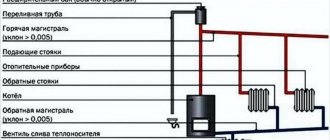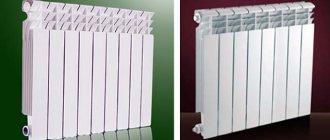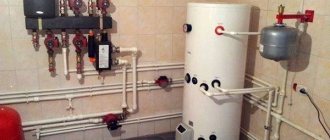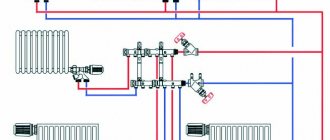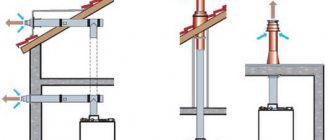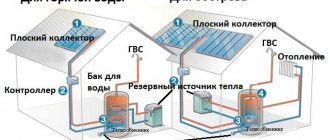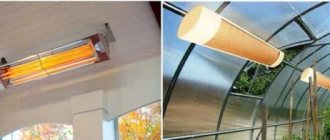Any person knows perfectly well that heating or central heating is created to provide comfortable living conditions. Many people know approximately the structure and how the central heating system generally works, as well as its standards.
To briefly recall, the heating process is carried out due to the thermal center, inside of which heat exchangers are located. Moreover, their location can be anywhere. For example, they can be placed in a boiler room, in a station, etc. Central heating is divided into several types: water heating, air and steam. But at the present time, combined heating is in greatest demand.
How is central heating arranged in an apartment building, and what are its differences with the central heating system of a private house?
Central heating in an apartment building
In order to compare heating in a private and apartment building, you first need to consider them separately. Let's start with an apartment building. To heat just such houses, water heating is often used, and it consists of approximately this:
- Plugs that separate the heating main from a residential building. It is they who divide the pipeline into 2 parts, external and internal. The heating service is responsible for the external part, but the utilities are responsible for the internal part of the pipe.
- Pipe tappings. They are usually located on the pipelines themselves, where hot water flows, as well as return ones. It is by using them that water can be distributed.
- Heating elevator. It is used to regulate the system in terms of water temperature. The point is that there is a mixing of cold and hot water.
- Plugs. They are necessary in order to cut off the heating main from the residential building.
- Valves, vents. When the time comes for repairs, it is through them that the water is discharged.
The central heating system structure in an apartment building has, inside the building, various spills that look like pipes. But through them the coolant, that is, water, rises into the risers. You can even give an example. If you still live in an old house, then in the basement you can see the lower spills, which are where the risers come from.
But there is one drawback. It is this method of fixation that has a big disadvantage. There is a very high probability that the coolant inside the system may freeze. This is a common occurrence in winter. This happens because in cold weather the water circulation does not stop.
And in order to prevent this problem, it is necessary to pay attention to compaction. If in a private house, then the air vents are often located at the top of the building. With their help, excess air is released.
But if you live in a multi-story building, the spill will be in the attic. It is precisely this type of arrangement that allows distribution to risers, right when the heating is turned on. And there are no problems with air getting in, it simply doesn’t get into the risers. This is what separates the top spill from the bottom.
The principle of operation of a centralized heating system
This option for heating a room in an apartment has a lot of features that should definitely be mentioned.
Firstly, central heating in a private house (this option is also found) and in an apartment involves generating heat in a completely different room from where the heating occurs. The place where heat energy is obtained is usually either a local boiler house or a thermal power plant. It is from there that the coolant, heated to the required temperature, enters the apartments through a pipeline.
There are two categories of centralized heating systems - water and steam, which explains the presence of steam and water boilers in boilers. The source of energy in this case is different types of fuel (coal, gas, wood waste, etc.).
After the temperature of the water in the central heating reaches the desired value, it enters the pipes, from where it is subsequently transferred to the heating radiators. In these devices, the water gradually cools down and then returns back to the heating point.
Many boiler houses pre-clean it with a special chemical composition immediately before supplying water to apartments. In this case, first of all, the hardness of the coolant is reduced, in addition, excess oxygen and carbon dioxide are removed from it. The purpose of this treatment is to prevent the appearance of scale and corrosion formations inside the pipe system.
Heating devices inside apartments and temperature conditions
The type of radiators that are installed in the house depends on the type of building. Let’s say if the building is from Soviet times, then the following types of radiators will be noticed:
- Metal convectors. The body is made of steel, inside there are coils of pipe, along with connecting sections.
- Cast iron batteries. This is the most common option that can be noticed. Not only are they very heavy, but they also have a high level of heat transfer. But only one drawback can be attributed to them - the appearance is average, and there are leaks.
Also, the size of the batteries, or their individual elements, will depend on which floor you place them on. Circulation is also important. Let's give an example. If the circulation is upper, then the closer to the first floor, the lower the temperature will be.
The same goes for the opposite. But you can make one move. It is better to install lower circulation, and the higher your apartment is located, the more compartments you will have to make or increase the size of the radiator.
But in modern houses they usually install bimetallic batteries. But the point is that there is already a water central heating system.
Briefly about bimetallic radiators. They are made from 2 types of metal, usually aluminum and another metal. Aluminum, in turn, has a very high level of heat transfer, about 200 Watt. And whether you buy this type of radiator or not is up to you to decide. After all, you will have to spend money on buying it first, and it is far from cheap.
Let us also note a little about the temperature standard that should be in each room, in accordance with SNiP.
- in the bathroom it’s supposed to be about 25 degrees;
- in the kitchen +22;
- living quarters +22 degrees.
Naturally, all standards are specially designed so that each room has the required heat level. Also, the temperature of the water in the pipes must be certain. It is very important that it does not exceed +95 degrees.
The point is that the central heating system in an apartment building works quite productively, but it is the boiler room that is responsible for heating the living rooms. It is for this reason that the central heating system is slightly inferior to the autonomous heating of a private house.
Technological connection to heating networks
The amount of payment for technological connection is established by the authorized executive body in the field of state regulation of tariffs.
The cost of services is calculated by PJSC "MOEK" as part of the preparation of an offer for an Agreement on connection of a specific facility, based on the technical solution prepared based on the results of consideration of the Application.
Regarding connection to the heating system:
For 2021, the order of the Department of Economic Policy and Development of Moscow dated November 12, 2018 No. 129-TR “On establishing fees for connecting to the heat supply system of the public joint stock company “Moscow United Energy Company” in the territory of the city of Moscow for 2021” is in effect.
If technically possible, the cost of connection depends on the size of the connected load.
If the connected load is less than 0.1 Gcal/hour, the connection cost is 550 rubles, including VAT.
If more than 0.1 Gcal/hour, then the cost of connection depends on the installation method, network diameter and the need for construction/reconstruction of a heating point and is calculated in accordance with Order of the Department of Economic Policy and Development of Moscow dated August 30, 2017 No. 145-TR based on Order of the Federal Tariff Service of Russia dated June 13, 2013 N 760-e on the approval of Methodological Guidelines for calculating regulated prices (tariffs) in the heat supply sector.
If there is no technical possibility of connection, the heat supply organization prepares an individual project and sends it to the Department of Economic Policy and Development of Moscow to determine the amount of the connection fee. After the connection fee has been established by the Moscow Department of Economic Policy and Development, the heat supply organization sends the signed draft Agreement in 2 copies to the Applicant within 20 working days.
Regarding connection to the Central Water Supply Center:
For 2021, the order of the Department of Economic Policy and Development of Moscow dated November 30, 2018 No. 229-TR “On establishing tariffs for connection (technological connection) to the centralized hot water supply system of the public joint-stock company “Moscow United Energy Company” for 2021” is in force. as well as the order of the Department of Economic Policy and Development of Moscow dated April 3, 2019 No. 31-TR “On amendments to the order dated November 30, 2018 No. 229-TR.”
Heating a private house
In recent days, the central heating system is found quite often in private homes. This heating system in a two-story house is often heating using a coolant generator, which plays the role of a central boiler room.
Connection process
This process is carried out only after all documents and necessary permits have been signed. They are drawn up between the owner of the apartment and the company that will carry out this connection. Let us briefly consider several types of central heating connections to private houses:
- Direct-flow circuit (dependent).
- Independent scheme.
- Dependent circuit, but using elevator installation.
Direct flow circuit (dependent)
This is the simplest option for connecting a central heating center. It lacks all expansion tanks, various faucets and other parts. It consists only of pipes and batteries. The best thing is that it can easily withstand strong pressure. But there is one drawback - the temperature of your home will be completely dependent on the operation of the central boiler.
Independent circuit
The presented scheme is used very often and is in great demand. Basically, it is installed when they cannot independently increase the pressure inside the system.
You can give an example. If the pipes in your home system are made of plastic, then you will definitely need a similar system. Moreover, it contains and uses a circular pump.
Dependent diagram with elevator installation
The latter option is often used for the purpose of heat transfer. In general, dependent circuits are often used, but in this option it is necessary to install an elevator, that is, a transition device. The elevator itself is necessary to ensure that heat is transferred from the main heating network. It is this that increases the feed speed and increases power.
Any central heating scheme you choose for an apartment building or a private one will be good!
Features of central heating in a private house
An agreement on the possibility of providing thermal energy, concluded between the supplier represented by the main boiler house and the owner of a private house (consumer), is a sufficient basis for connecting to the central heating network. There are three types of circuits for connecting the consumer to the main boiler room:
Regardless of the type chosen, work cannot begin without completing the accompanying documentation . Permission is issued by certain government bodies.
Let's draw some conclusions
As you may have noticed, installing a central heating system in a private house is quite possible. The most important thing is to prepare your money and still calculate which option is best for you. And so more experts advise choosing a dependent connection scheme, but using an elevator.
The advantage here is that you do not need to purchase a pump. In addition, as a rule, in Moscow, you can purchase these systems very quickly! So it’s better to explore all the options and get to work!
